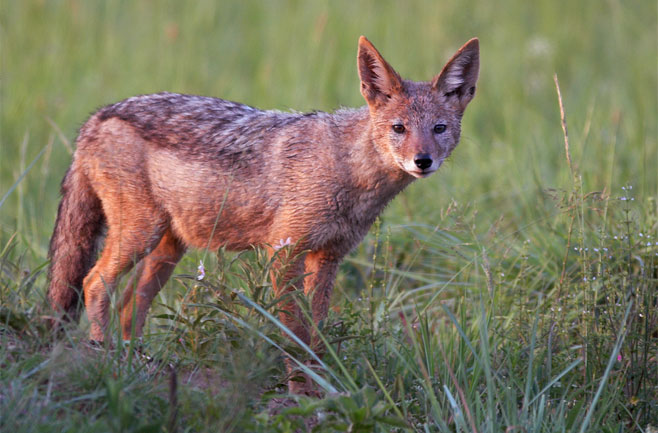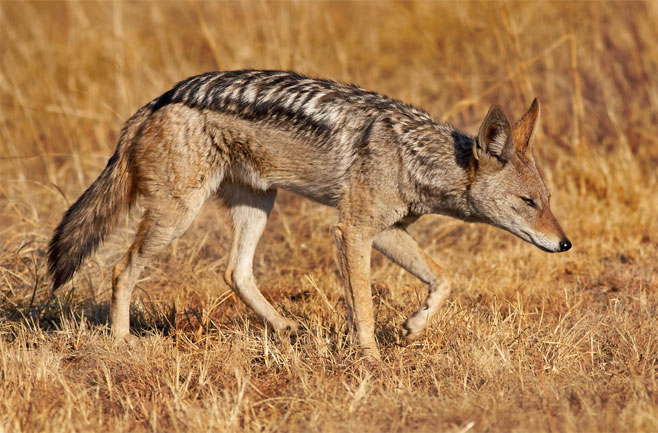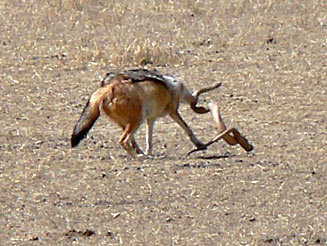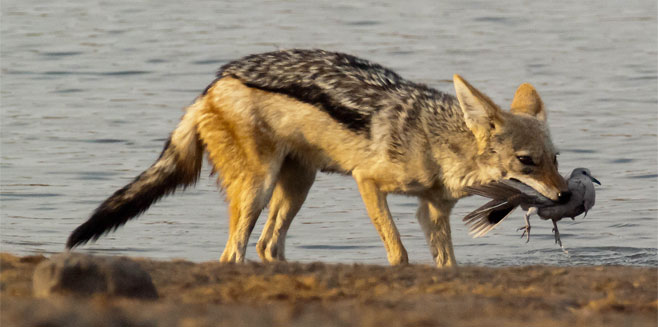|
Canis mesomelas (Black-backed jackal)
rooijakkals, swartrugjakkals [Afrikaans]; Schabrackenschakal
[German]; chacal ŕ chabraque [French];
bweha nyekundu [Swahili]; ikhanka, ipungutjha enzima [isiNdebele];
impungutye [isiXhosa]; impungushe, ikhanka, inkanka [isiZulu];
phukubję, phokobję [Sepedi]; phokobje, phokojoe, phokojwe [Sesotho];
phokobję, phokobyę, phokojwę, phokoję, sekgęę [Setswana]; hunguabwe [Shona];
mpungutje, impungutjee, imphungushe, jakalasi [siSwati]; mhungubya,
phungubya, hungudzwa, jajaja [Zitsonga]; phungubwe, phunguhwe, phunguhwei re
na mutana mutswu [Tshivenda]; |Girib,
|gireb [Nama, Damara]
Life
>
Eukaryotes >
Opisthokonta >
Metazoa (animals) > Bilateria > Deuterostomia >
Chordata > Craniata > Vertebrata (vertebrates) >
Gnathostomata (jawed vertebrates) > Teleostomi (teleost
fish) > Osteichthyes (bony fish) > Class:
Sarcopterygii (lobe-finned fish) > Stegocephalia
(terrestrial vertebrates) > Reptiliomorpha > Amniota >
Synapsida (mammal-like reptiles) > Therapsida > Theriodontia
> Cynodontia > Mammalia (mammals)
> Placentalia (placental mammals) > Laurasiatheria
> Ferungulata > Ferae > Carnivora > Family:
Canidae (foxes, dogs and jackals)
 |
|
Canis mesomelas (Black-backed jackal),
Rietvlei Nature Reserve, South Africa. [photo
Philip
Fourie ©] |
 |
|
Canis mesomelas (Black-backed jackal),
South Africa. [photo
Philip
Fourie ©] |
Widespread in southern Africa but has been
exterminated in some farming areas as it attacks livestock. Pairs
mate for life and rear their litters in underground burrows made by
other animals. They are sometimes assisted by subadults from their
previoius year's litter. They eat a wide range of prey from
invertebrates to small antelope and even consume fruit.
Identification
The black-backed jackal refers to the
distinctive broad black saddle that extends over the upper parts
from the neck to the base of the tail. The black saddle is liberally
flecked with white hair. In appearance, this species resembles a
medium sized dog. The face, flanks and legs are a reddish brown in
colour, with the underparts lighter. The muzzle is pointed, with the
lips throat and chest white. The ears are pointed, erect and
relatively large, they are reddish and lined with white hair on the
inner edge. The black tail is very bushy. The dentition is
well-adapted for varied diet of an omnivorous species. The sharp,
curved canines are adapted for the catching and holding of prey. The
well-developed carnassial teeth are used for slicing and the broad
molars for grinding.
Size
Total Body Length: 96-110 cm; height at
shoulder 38 cm; weight range 6 -10 kg.
Dental Formula
I C C P P M M =
42 =
42
Distribution and habitat
Widespread in southern African subregion, but
absent from the north-east. They have a wide habitat tolerance but
prefer drier areas, from the arid Namib desert to the moist
Drakensberg.
General behaviour
The black-backed jackal is mainly active at
night (nocturnal) but they are often seen during the day in
protected environments where there is little human disturbance.
Normally solitary or in pairs, but they may occur in family parties
that include the sub-adults from the previous year. When resting
they lie in burrows dug by other animals, rock crevices or concealed
in thick bush thickets. However, in areas where they are protected
they will rest in more open areas from where they can survey their
surroundings.
Food
Jackals are adept at finding any source of
food, including carrion. They are also skilled hunters of small
birds,
reptiles and mammals (e.g. small
antelope) and readily eat
insects and fruit. Jackals are regarded as wary and cunning and are
extremely difficult to trap.
The territorial call is a long drawn out
high-pitched wavering howl that is followed by staccato yaps. It is
one of the characteristic calls of the African night. A persistent
alarm call is used when danger or a predator is sighted.
 |
 |
|
This Black-jacked jackal attacked this mole snake
presumably to eat it but as can be seen in the left-hand photo, the
snake manage to bite the jackal. After that the jackal had anothe go at
subduing it - don't know if it eventually managed to kill it and eat it.
Photographed in Kgalagadi Transfrontier Park by
Lorinda Steenkamp
©. |
 |
|
Black-backed jackal with a freshly caught Cape
turtle-dove. It waited until the moment that the dove dipped its head in
the water to drink, then grabbed it in a rapid attack. See the
Flickr photoset for the full story. [© 2011,
Pim Stouten] |
Reproduction
Mated pairs are territorial and both the male
and the female will mark and defend their territory. Pairs mate for
life (monogamous), and family groups consist of parents and their
offspring. Gestation lasts about 60 days. Litters of 1-6 (usually 3)
cubs are born from July to October, in underground burrows dug by
other species. Both the male and female bring food to the young
often assisted by “helpers” – subadults from the previous breeding
season. The young start to forage with their parents when they are
about 14 weeks old, at this stage they no longer use the den. Life
span: 4-8 years.
Predators, parasites and commensals
Predators occasionally include large raptors
and caracal and they succumb to diseases such as rabies and
distemper.
Conservation
Unfortunately the Black-backed jackal can be a
problem to sheep and goat farmers by killing live stock and are
regarded as vermin. Determined extermination programmes have
resulted in the species being completely eradicated from some areas
in their distribution range. Currently the species is not regarded
as threatened.
Text by Denise Hamerton |
